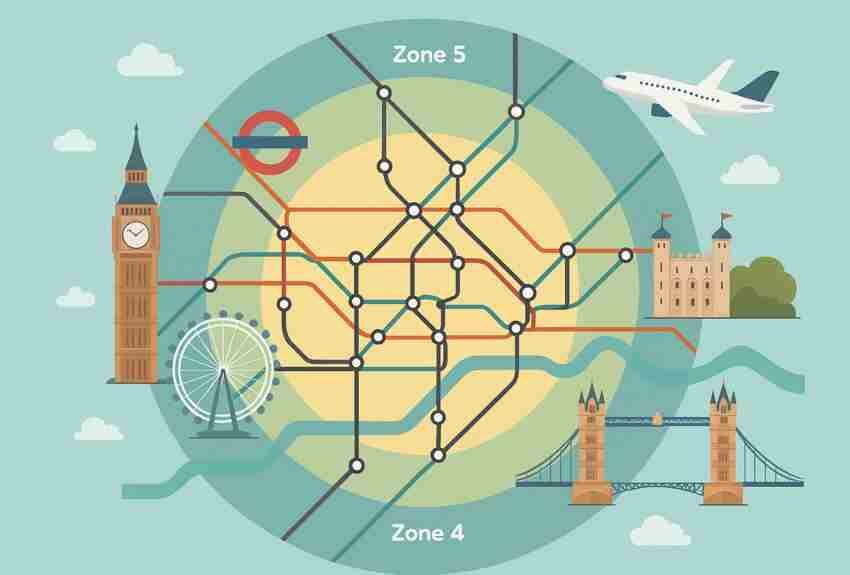
London, a vibrant city brimming with history, culture, and innovation, is one of the most popular destinations for international students and travelers alike. While living or studying in London can be exciting, understanding its transport system is crucial for navigating the city efficiently. This guide explains London travel zones 1-6, ensuring you know how to get around without confusion or unnecessary expense.
Whether you’re a student figuring out your commute to college or a newcomer trying to explore London’s attractions, understanding London zones will make your experience smoother.
What Are London Travel Zones?
London’s public transport system, operated by Transport for London (TfL), divides the city into six concentric travel zones. These zones start from Zone 1, which includes the city center, and extend outward to Zone 6, covering the suburbs and outer areas.
The fare you pay depends on the zones you travel through, making it essential to know which zone your destination falls into. Here’s a quick breakdown of how many zones in London and what they include:
| Zone | Area Covered | Key Features |
| Zone 1 | Central London | Famous landmarks like Big Ben, the Shard, and Trafalgar Square |
| Zone 2 | Inner London | Popular neighborhoods like Camden, Shoreditch, and Hammersmith |
| Zone 3 | Suburbs close to the center | Residential areas like Wimbledon and Stratford |
| Zone 4 | Outer London | More affordable living options, quieter areas |
| Zone 5 | Outer suburban areas | Proximity to Heathrow Airport and scenic parks |
| Zone 6 | Farthest outskirts of London | Locations like Croydon and Orpington |
How London Zones Work
The zones are not just for the London Underground (Tube); they also apply to other public transport services like buses, trams, and the Overground. Understanding the zones can save you money and help you choose accommodation that minimizes your commute.
- Travel Passes and Fares: Travel cards and Oyster cards calculate fares based on the number of zones you cross. For example, a journey from Zone 1 to Zone 4 costs more than a trip within Zone 1.
- Daily Caps: TfL applies a daily cap to fares. If you use public transport multiple times a day, you won’t pay more than the capped amount, making it budget-friendly.
- Zone Overlap: Some stations fall in overlapping zones (e.g., Zone 2/3). This can reduce your fare if planned wisely.
Key Highlights of Each Zone
Zone 1: The Heart of London
Zone 1 is London’s central hub, home to iconic landmarks, top universities, and vibrant neighborhoods.
- Top Attractions: Buckingham Palace, London Eye, British Museum.
- Universities: University College London (UCL), London School of Economics (LSE).
- Living Cost: Accommodation in London is expensive, with rent averaging £1,500–£2,500 per month for a one-bedroom flat.
Zone 2: Trendy and Convenient
Zone 2 surrounds the city center and offers a mix of urban excitement and residential calm.
Zone 3: Balance of Cost and Convenience
Zone 3 is perfect for students and families seeking affordable housing while staying connected to the city center.
- Key Areas: Stratford (home to the Olympic Park), Ealing, and Acton.
- Perks: Lower living costs and plenty of green spaces.
- Living Cost: Rent here averages £1,000–£1,500 per month.
Zone 4: Affordable and Family-Friendly
Zone 4 offers suburban charm and spacious living at a reasonable cost.
- Neighborhoods: Richmond, Ilford, and Bromley.
- Why Choose Zone 4?: Ideal for those looking for peace and quiet without straying too far from the action.
- Living Cost: Monthly rent is between £900–£1,300.
Zone 5: Gateway to Suburban Life
As you move further out, Zone 5 brings a quieter lifestyle with parks and larger homes.
- Areas: Kingston, Harrow, and Heathrow.
- Perks: Proximity to Heathrow Airport makes it convenient for international students.
- Living Cost: Flats here cost £800–£1,200 per month.
Zone 6: The Outskirts of London
Zone 6 is ideal for those who prioritize budget over proximity to the city center.
- Areas: Croydon, Orpington, and Uxbridge.
- Living Cost: Rent averages £700–£1,100 per month, making it the most affordable.
Tips for Navigating London Zones
- Plan Your Accommodation Wisely: Choose a zone that balances your budget, travel time, and lifestyle preferences. For instance, living in Zone 2 offers easy access to the city while being more affordable than Zone 1.
- Get an Oyster Card: This contactless card simplifies travel and offers discounted fares for students.
- Use TfL Apps: Download TfL’s journey planner app to map out routes, check fares, and get live updates.
- Explore Off-Peak Travel: Fares are cheaper during off-peak hours (after 9:30 AM on weekdays).
How to Save on Transport Costs
Transport can be a significant expense for students, but with some planning, you can reduce costs.
| Transport Pass | Cost (Per Week) | Best For |
| Student Oyster Card | £25–£35 | Unlimited travel within selected zones |
| Contactless Payments | Pay-as-you-go | Flexible travel for occasional trips |
| 16-25 Railcard + Oyster | 1/3 discount | For discounted fares on train journeys |
Common Challenges and Solutions
- High Transport Costs: Use a weekly travel card or daily cap to manage expenses.
- Complex Routes: The Tube map may seem daunting, but apps like Citymapper simplify navigation.
- Peak Hour Crowds: Travel during off-peak hours to avoid congestion.
Conclusion
Understanding London travel zones 1-6 is the key to navigating the city efficiently. Whether you’re a student or an international traveler, choosing the right zone for accommodation and learning how to manage transport costs can significantly enhance your experience.
With this ultimate guide, you’re now equipped to make informed decisions, minimize costs, and enjoy all that London has to offer. So grab your Oyster card, plan your route, and get ready to explore one of the world’s most exciting cities!
